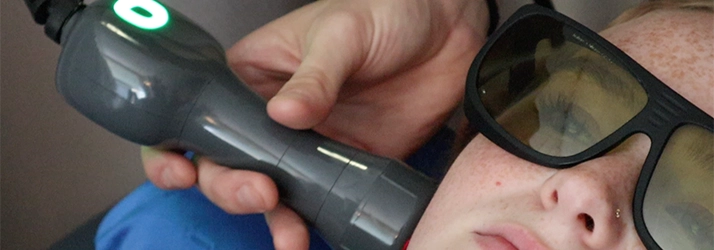Chiropractic Treatment for TMJ (Can a Chiropractor Help with Pain?)

If you're wondering, "does seeing a chiropractor help with TMJ?" then we have some good news for you. Not only does chiropractic treatment for TMJ help ease the pain when you visit a chiropractor but you can also do some soft tissue work at home to help loosen up your jaw muscles and reduce pain.
In this article, we demonstrate some exercises you can do at home to help ease your TMJ pain and you'll also see how seeing a Towson MD chiropractor to help with TMJ works and what you can expect.
What Is TMJ?
Temporomandibular disorder (TMD), more commonly known as TMJ is a blanket term for acute or chronic inflammation of the temporomandibular joint (which is what connects your mandible to your skull). TMJ refers to a wide variety of conditions that affect TM joints, jaw muscles, and facial nerves.
Your jaw joint, also known as the TM joint, can be found on either side of your head and it exists to connect the lower jaw bone (that's your mandible) to the temporal bones of the skull on each side of the head. The muscles controlling the joints are attached to the mandible and allow the jaw to move.
When you open your mouth, the rounded upper ends of the mandible on each side of the jaw glide along the joint socket at the base of the skull. Then when you close your mouth they slide back to their original position. This is where many people with TMJ hear popping in their jaw.
TMJ is very common and the causes include injury/trauma to the jaw, teeth grinding while awake or sleeping, nail-biting, degenerative joint diseases like arthritis, infections, and autoimmune diseases. Approximately 12% of the US population is experiencing TMJ at any time and many of them don't realize that a chiropractor can help with the pain associated with TMJ.
TMJ has a range of symptoms including pain in or around the ear, headaches, neck pain, jaw pain and soreness, jaw pain when biting or chewing, difficulty opening and closing the mouth, popping or clicking noises when opening the mouth, jaw stiffness, tinnitus, dizziness, and even sensitive teeth when no other dental problems can be found. The wide range of these symptoms shows just how much your jaw muscles impact the surrounding joints and muscles.
Chiropractic Treatment For TMJ in Towson MD
When you visit us with jaw pain we'll focus on 3 key muscles: the masseter, the temporalis, and the pterygoid. We'll also pay close attention to the suboccipital muscles, jaw joint itself and the top 2 vertebrae because they greatly impact the jaw joint and we want to make sure everything is aligned properly.
Your masseter is a thick, deep muscle in the upper jaw area that plays a major role in chewing. If you put your hand on your cheek and open and close your mouth you can feel your masseter flexing. Your temporalis is a thinner, clam-shaped muscle on each side of the head. This muscle is crucial for chewing and covers a broader area than the masseter including your temples.
In order to work on the masseter, place two fingers flat against your jaw. Press in with flat fingers and then up to put pressure on your masseter and then open and close your mouth. From there, you can move up to the next part of the masseter and continue to do a total of 3 repetitions to complete 1 set of this exercise. If you're having jaw pain, we recommend doing 3 sets of this exercise 3 times per day.
This same exercise can be applied to the temporalis as well. When working on the temporalis you'll want to use all 4 finger pads as it is a broader muscle. Use the same movement and pressure as you did in the masseter exercise but remember, the temporalis will require less pressure than the masseter because it is a thinner muscle. We recommend 3 sets of this exercise on your temporalis 3 times per day for TMJ jaw pain.
Doing soft tissue work on the pterygoid is more complicated to do yourself so you'll want to consult a chiropractor for this. The pterygoid release requires leverage against the cheek in between your cheek and your teeth. This is typically the most uncomfortable soft tissue to work on for TMJ because it's often not as strong as your masseter or temporalis.
Once we've completed soft tissue work for jaw pain we move on to adjust and assess the jaw in a TMJ chiropractic adjustment. We feel for which side of the jaw joint opens the least amount and which one opens last to identify which side should be worked on first. We adjust the stuck side of the jaw first and then the other side with a light push motion. After this adjustment, we reassess and often find that the jaw joint is realigned. If needed, TMJ treatment can be combined with dry needling if the jaw is very tight or with a class 4 laser treatment to speed up the healing process of the tissue.
Does seeing a chiropractor help with TMJ? It absolutely does and we treat many patients who have TMJ and the jaw pain that comes along with it.
Do you suffer from TMJ?
Click on the button below to schedule your TMJ chiropractic adjustment appointment.
IF YOU'D LIKE TO LEARN MORE ABOUT OUR NEWSLETTER, SUBSCRIBE BELOW
FOR MORE INFORMATION, FILL OUT THE FORM BELOW
OFFICE HOURS
Monday
7:30am - 12:00pm
2:00pm - 6:00pm
Tuesday
7:30am - 12:00pm
2:00pm - 6:00pm
Wednesday
7:30am - 12:00pm
2:00pm - 6:00pm
Thursday
7:30am - 12:00pm
2:00pm - 6:00pm
Friday
7:30am - 12:00pm
Saturday & Sunday
Closed
Kalkstein Chiropractic
200 E Joppa Rd #300
Towson, MD 21286